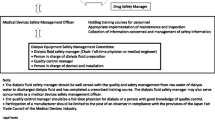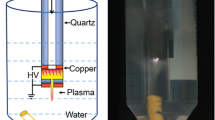Abstract
Various benefits have been attached to purifying the dialysis fluid used for hemodialysis therapy. The central dialysis fluid delivery system can treat approximately 50 dialysis patients simultaneously and is convenient to operate. In contrast, the dialysis fluid supply piping is complicated, and bacterial growth can cause biofilms. This study aimed to develop sustainable cleaning strategies to solve the complicated dialysis fluid piping, which is a weakness of the central dialysis fluid delivery system, and provide ultrapure dialysis fluid for a long term. Combination of heat water disinfection, continuous water circulation, and minimalized dead space in the dialysis piping were designed for a central dialysis fluid delivery system and used in a clinic for 6 years. As an index of water purification, endotoxin concentrations and microbial colony counts in reverse osmosis water and dialysis fluid were measured. In addition, we performed scanning electron microscopy of the silicon tube surface that had been used for 5 years to confirm the presence or absence of biofilm formation. For 6 years, endotoxin concentrations and microbial colonies were not detected in reverse osmosis water and dialysis fluid using the multiple-patient dialysis fluid supply equipment. The purity of the dialysis fluid was maintained. No biofilm formation was observed by scanning electron microscopy. Combination of heat water disinfection, continuous water circulation, and minimalized dead space designs for dialysis piping can supply ultrapure dialysis fluid with minimal biofilm formation in the piping in the long term.


Similar content being viewed by others
References
Baz M, Durand C, Ragon A, Jaber K, Andrieu D, Merzouk T, Purgus R, Olmer M, Reynier JP, Berland Y. Using UltraPure water in hemodialysis delays carpal tunnel syndrome. Int J Artif Organs. 1991;14:681–5.
Schiffl H, Lang SM, Bergner A. UltraPure dialysate reduces dose of recombinant human erythropoietin. Nephron. 1999;83:278–9. https://doi.org/10.1159/000045525.
Mineshima M, Kawanishi H, Ase T, Kawasaki T, Tomo T, Nakamoto H. 2016 update Japanese Society for Dialysis Therapy Standard of fluids for hemodialysis and related therapies. Ren Replace Ther. 2018. https://doi.org/10.1186/s41100-018-0155-x.
Nitta K, Goto S, Masakane I, Hanafusa N, Taniguchi M, Hasegawa T, Nakai S, Wada A, Hamano T, Hoshino J, Joki N, Abe M, Yamamoto K, Nakamoto H. Annual dialysis data report for 208, JSDT Renal Data Registry: survey methods, facility data, incidence, prevalence, and mortality. Ren Replace Ther. 2020. https://doi.org/10.1186/s41100-020-00286-9.
Kawanishi H. Development of online hemodiafiltration in Japan. Ren Replace Ther. 2021. https://doi.org/10.1186/s41100-021-00370-8.
Koda Y, Mineshima M. Advances and advantages in recent central dialysis fluid delivery system. Blood Purif. 2009;27:23–7. https://doi.org/10.1159/000213494.
Himmelfarb J, Vanholder R, Mehrotra R, Tonelli M. The current and future landscape of dialysis. Nat Rev Nephrol. 2020;16:573–85. https://doi.org/10.1038/s41581-020-0315-4.
Hasan M, Sutradhar I, Gupta RD, Sarker M. Prevalence of chronic kidney disease in South Asia: a systematic review. BMC Nephrol. 2018;19:291. https://doi.org/10.1186/s12882-018-1072-5.
Elsayed HM, Mahmoud BL, Hassan MS, Moustafa AEEM. Effect of central dialysis fluid delivery system (CDDS) on IL6 & CRP levels in prevalent haemodialysis patients. An Int J of Med. 2021. https://doi.org/10.1093/qjmed/hcab100.012.
Masakane I, Kawanishi H, Mineshima M, Takemoto Y, Uchino J, Hoshino T, Igoshi T, Hirakata H, Akizawa T, Japanese Society for Dialysis Therapy. 2011 JSDT standard on the management of endotoxin retentive filter for dialysis and related therapies. Ther Apher Dial. 2013;17:229–40. https://doi.org/10.1111/1744-9987.12031.
Schindler R, Beck W, Deppisch R, Aussieker M, Wilde A, Göhl H, Frei U. Short bacterial DNA fragments: detection in dialysate and Induction of cytokines. J Am Soc Nephrol. 2004;15:3207–14. https://doi.org/10.1097/01.ASN.0000145049.94888.26.
Gejyo F, Yamada T, Odani S, Nakagawa Y, Arakawa M, Kunitomo T, Kataoka H, Suzuki M, Hirasawa Y, Shirahama T, Cohen AS, Schmid K. A new form of amyloid protein associated with chronic hemodialysis was identified as β2-microglobulin. Biochem Biophys Res Commun. 1985;129:701–6. https://doi.org/10.1016/0006-291X(85)91948-5.
Locatelli F, Martin-Malo A, Hannedouche T, Loureiro A, Papadimitriou M, Wizemann V, Jacobson SH, Czekalski S, Ronco C, Vanholder R, Membrane Permeability Outcome (MPO) Study Group. Effect of membrane permeability on survival of hemodialysis patients. J Am Soc Nephrol. 2009;20:645–54. https://doi.org/10.1681/ASN.2008060590.
Abe M, Masakane I, Wada A, Nakai S, Nitta K, Nakamoto H. Super high-flux membrane dialyzers improve mortality in patients on hemodialysis: a 3-year nationwide cohort study. Clin Kidney J. 2022;15:473–83.
Kikuchi K, Hamano T, Wada A, Nakai S, Masakane I. Predilution online hemodiafiltration is associated with improved survival compared with hemodialysis. Kidney Int. 2019;95:929–38. https://doi.org/10.1016/j.kint.2018.10.036.
Okada K, Michiwaki H, Tashiro M, Inoue T, Shima H, Minakuchi J, Kawashima S. Effects of Japanese-style online hemodiafiltration on survival and cardiovascular events. Ren Replace Ther. 2021. https://doi.org/10.1186/s41100-021-00385-1.
Pérez-García R, García Maset R, Gonzalez Parra E, Solozábal Campos C, Ramírez Chamond R, Martín-Rabadán P, Sobrino Pérez PE, Gallego Pereira O, Dominguez J, de la Cueva Matute E, Ferllen R. Comisión de Expertos de la Sociedad Española de Nefrología Para la Creación de la Segunda Edición de la Guía de Gestión de Calidad del Líquido de Diálisis. Guideline for dialysate quality of Spanish Society of Nephrology;36. Nefrol 2016. pp. e1–e52. https://doi.org/10.1016/j.nefro.2016.01.003 (2nd ed., 2015) (2nd ed., 2015).
Nozaki H, Tange Y, Inada Y, Uchino T, Azuma N. Leakage of endotoxins through the endotoxin retentive filter: an in vitro study. Blood Purif. 2022;12:1–9. https://doi.org/10.1159/000520792.
Acknowledgements
We kindly acknowledge the clinical engineers at Makinose Urological Clinic for their support in achieving this study’s purpose.
Funding
This research has not received any specific grant from funding agencies in the public, commercial, or not-for-profit sectors.
Author information
Authors and Affiliations
Contributions
Fumiyo Ohno and Yoshihiro Tange contributed to the conception and design of the study, data analysis and interpretation, and drafting of the manuscript. Fumiyo Ohno and Shinichi Makinose contributed to the data collection. All authors are accountable for all aspects of the study; they worked on and approved the final version to be submitted.
Corresponding authors
Ethics declarations
Conflicts of interest
The authors report no proprietary or commercial interest in any product mentioned or concept discussed in this article.
Additional information
Publisher's Note
Springer Nature remains neutral with regard to jurisdictional claims in published maps and institutional affiliations.
Rights and permissions
Springer Nature or its licensor holds exclusive rights to this article under a publishing agreement with the author(s) or other rightsholder(s); author self-archiving of the accepted manuscript version of this article is solely governed by the terms of such publishing agreement and applicable law.
About this article
Cite this article
Ohno, F., Makinose, S. & Tange, Y. Effectiveness of combination of heat water disinfection, continuous water circulation, and minimalized dead space for dialysis piping in maintaining ultrapure dialysis fluid and preventing biofilm formation in a central dialysis fluid delivery system. J Artif Organs 26, 220–225 (2023). https://doi.org/10.1007/s10047-022-01362-z
Received:
Accepted:
Published:
Issue Date:
DOI: https://doi.org/10.1007/s10047-022-01362-z




